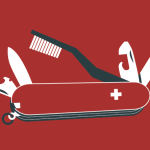Escape
Creativity is the act of combining existing elements to create something new. To come up with innovative ideas it’s essential to suspend your judgement, to generate as much ideas as possible (for quantity leads to quality) and to use thinking techniques to bring structure to the thinking process.
A thinking technique can help you break free from fixed thinking patterns. It helps you to ‘force’ your brain on a side track and to approach your challenge from a different angle. If you desire truly unique and unusual ideas, the use of thinking techniques cannot be overestimated.
There are many techniques to choose from. In previous articles we already described how Wishful Thinking, random input, Exaggeration and an analogy can lead you to brilliant ideas. These techniques help you look for solutions in unusual places. They force you to look at your problem with a fresh perspective or challenge you to use an unrealistic scenario as a stepping stone to a wonderfully creative idea. If you’ve read some of our articles, you probably also know that challenging your assumptions is key to finding exciting new ideas. Luckily there is a thinking technique that enables you to do exactly this…
Escape
The technique ‘Escape’ is based on the thought that most people (if not all people) have a head filled with assumptions. We constantly assume to know what other people think. We expect things to happen in a certain way (because we’ve seen it happen dozens of times before). And, most importantly, we assume some things can only be done right in one or two ways. Businesses are equally biased and assume to know all about their product or service. They ‘know’ their product has to meet certain requirements and they are sure that only fools would question the most basic elements that ALL these products or services share. Bottom line: if you’re a human being and/or active in a business you might want to continue reading.
While most people and companies spend their days being prisoners of their own beliefs, escaping these assumptions is actually remarkably easy. All you really have to do is follow these three simple steps:
Step 1: Write down five requirements that are inevitable in your situation. What does your product, service or situation ALWAYS have? What would be absolutely impossible to leave out? (for instance: one might say that a bank always deals with money, a luxury car showroom must have cars to show and a restaurant undoubtedly needs a cook)
Step 2: Pick one of your written assumptions and cross it out. Try to cross out the thing that is most IMPOSSIBLE to leave out, for this usually will lead to the most revolutionary ideas.
Step 3: Give yourself a short period of time (say 5 minutes) to write down as much ideas as possible on how to make your product or service work WITHOUT this ‘necessity’. Can you find ways to still make it work? Can you find ways to even improve your current service?
You can try this exercise alone, but it’s even more powerful to do it with a group. Start by writing down as much ideas as possible individually. After the designated time, discuss all the ideas and try to build on each other’s wacky suggestions. You might want to repeat the procedure and gradually work your way through all the assumptions you have about your product or service.
An example
Let’s see how this technique works with a simple example. Say you want to design a new type of computer keyboard. First of course, you write down all the essential elements of a keyboard. You might say for instance that a keyboard always has: keys, letter characters, a space bar and an oblong shape.
Now you cross out one of the keyboard-necessity’s. Say you decide to abandon the imprinted letters on the keys. How would a keyboard without letters still be valuable? What will this thought provoking idea lead to? Well, one possible idea would be to introduce a Braille-keyboard with little raised dots instead of printed letters. Or perhaps you have another target audience in mind: the large number of illiterates all over the world. Maybe you can design a keyboard with symbols and/or colours instead of letter-keys. You could of course go even further and let go of the typing-function altogether. You might think of a sign language ‘reader’. A machine that interprets your sign language and swiftly transcribes it. The keyboard could just as easily turn into a microphone that interprets your voice or a tablet that enables you to draw what you want. Whatever the escape from a ‘given’ rule might lead you to, there is a rather big chance that it’s more original than the thought you would otherwise have ended up with.
Once you start using this technique, you will soon find that virtually anything you encounter is subject to a bunch of assumptions. Who would have guessed a bar doesn’t have to sell alcohol, a butcher doesn’t have to sell meat and a children’s book doesn’t need words …or images.
I’d love to hear your experiences with this technique. What assumptions can you escape from?
Like this article?
If you enjoyed reading this article, feel free to share it with your network by hitting one of the buttons below. This way other people can benefit from the article as well.





